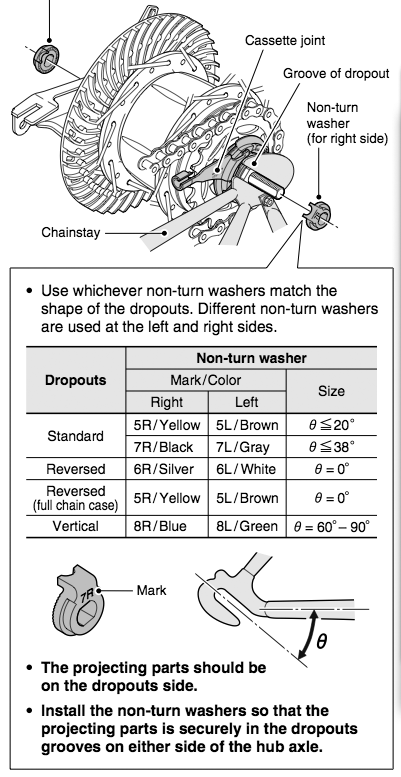Sheldon Brown's
Bicycle Glossary An - Az
|
|
![]()
In general, bicycles with shallower, "slack", "relaxed" angles (lower numbers) tend to be more stable and comfortable. Bicycles with steeper, more upright angles (higher numbers) tend to be manuverable, but less comfortable on rough surfaces. Shallower frames tend to have longer wheel bases than more upright frames; bicycles with shallower head angles normally have more fork rake. All of these factors contribute to the riding characteristics cited.
This practice is pretty much discredited these days. If carried to an extreme, it can cause injury. This happened to me when I was a teenager; I had read about ankling, and had just acquired my first pair of toe clips, just before setting out on my first overnight tour. I ankled for about the first 30-40 miles, when there was a sudden sharp pain in one of my Achilles tendons. I had to lower the saddle, remove the toe clips, and finish out the 4 day tour pedaling on my arches, because I couldn't bear the slightest load on the front of my foot, pulling on the Achilles tendons. For about a month thereafter, I would need to massage my Achilles tendons for about 5 minutes each morning before I would be able to walk. 40 years later, I've still not completely recovered from this injury.
![]()
![]()
Some rims are "hard" anodized, which produces a hard surface, harder than the natural aluminum, usually in a dark brown or black. This process was popular in the 1980s, as it was presumed to improve the durability of the rim's braking surface, and to make the rim more resistant to cracking around the spoke holes.
Unfortunately, the anodized braking surfaces did not provide as good a grip as natural aluminum, and they presented an unsightly appearance as the dark coating wore off of the sides of the rim.
Even more unfortunately, it developed that the harder surface was also more brittle, causing more problems with cracking around the spoke holes.

The 14 speed Rohloff Speedhub has such a wide gear range that simple anti-rotation washers aren't sufficient, so it uses either a special dropout or a reaction arm connecting to a disc brake braze-on.
Strictly speaking, this is probably a more linguistically pure term, as both parts of the word have Latin roots. "Hydroplaning" is mixed Greek/Latin, which is not favored by linguists.
The term "brake arch" does legitimately apply to the part of a suspension fork that links the sliders and contains the cable housing stop.
![]()
![]()
Similar Audax events also exist for hiking, swimming, rowing and cross-country skiing. Audax is a registered trademark of the Union des Audax Français.
It uses a standard derailer operated by a system of weights and springs in the rear wheel.
As the speed increases, the weights move outward due to "centrifugal force", pushing a ring that rubs on the derailer outward, causing the derailer to shift to a higher gear.
There is no provision for the rider to have any control over the gear shifting.
Avocet is best known for cyclecomputers, tires and saddles.
The Avocet 20 cyclecomputer was the first to sell for less than $40. Unfortunately, it was widely advertised, with a price of $24.95, for almost two years before it was actually ready to ship. This "vaporware" did great harm to the development of the cyclecomputer market for a couple of years. Avocet cyclcomputers work on an entirely different principle from all other makes.
Avocet was the first to market tires with perfectly smooth tread for road use. They are extremely good, but it is hard to convince people that they get good traction (they do!)
Avocet's first claim to fame was its saddles, which were the first serious alternative to traditional leather saddles. They were the first to use the "two-bump" design to reduce pressure on the perineum.
Avocet also used to market hubs and cranks made by Ofmega in Italy.
The name "Avocet" is pronounced "A-vo-cette". Despite appearances, it is an English word, not French, and refers to a particular shorebird species.
![]()
![]()

![]()
![]()
![]()
Last Updated: by Harriet Fell